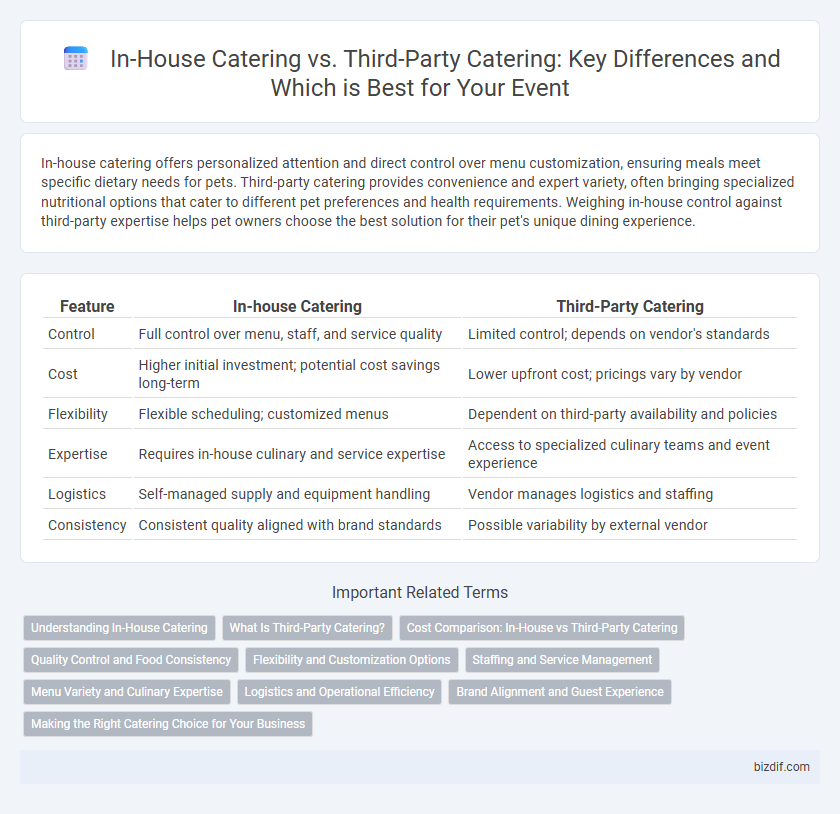In-house catering offers personalized attention and direct control over menu customization, ensuring meals meet specific dietary needs for pets. Third-party catering provides convenience and expert variety, often bringing specialized nutritional options that cater to different pet preferences and health requirements. Weighing in-house control against third-party expertise helps pet owners choose the best solution for their pet's unique dining experience.
Table of Comparison
| Feature | In-house Catering | Third-Party Catering |
|---|---|---|
| Control | Full control over menu, staff, and service quality | Limited control; depends on vendor's standards |
| Cost | Higher initial investment; potential cost savings long-term | Lower upfront cost; pricings vary by vendor |
| Flexibility | Flexible scheduling; customized menus | Dependent on third-party availability and policies |
| Expertise | Requires in-house culinary and service expertise | Access to specialized culinary teams and event experience |
| Logistics | Self-managed supply and equipment handling | Vendor manages logistics and staffing |
| Consistency | Consistent quality aligned with brand standards | Possible variability by external vendor |
Understanding In-House Catering
In-house catering involves managing all food preparation, staffing, and service internally, providing complete control over menu customization, quality, and scheduling to meet specific event requirements. This approach enhances consistency and brand alignment while potentially reducing long-term costs associated with outsourcing third-party vendors. Effective in-house catering requires investment in skilled personnel, kitchen facilities, and inventory management to ensure seamless execution and elevated guest experiences.
What Is Third-Party Catering?
Third-party catering refers to the outsourcing of food preparation and service to an external company rather than using in-house staff. These specialized vendors manage menu planning, food delivery, setup, and cleanup, offering flexibility and a wide range of culinary options tailored to events. Businesses often choose third-party catering to save on internal resources while ensuring professional quality and diverse cuisine choices.
Cost Comparison: In-House vs Third-Party Catering
In-house catering typically incurs higher fixed costs due to investments in kitchen equipment, staff salaries, and inventory management, while third-party catering offers flexible pricing based on event size and menu selection. Third-party catering eliminates overhead expenses and reduces the risk of food wastage, often resulting in lower overall costs for one-time or infrequent events. Businesses must evaluate volume, menu complexity, and control preferences to determine the most cost-effective catering solution.
Quality Control and Food Consistency
In-house catering provides direct oversight of quality control, enabling strict adherence to food safety standards and consistent preparation methods. Third-party catering may involve variability in food consistency due to reliance on external vendors with differing protocols. Establishing clear communication channels and detailed contracts is crucial to maintaining quality when outsourcing catering services.
Flexibility and Customization Options
In-house catering offers greater flexibility and customization options as it allows direct control over menu selection, ingredient sourcing, and service style tailored to specific event needs. Third-party catering provides a variety of pre-set packages and expertise but may have limitations in adjusting menus or accommodating last-minute changes. Businesses seeking personalized culinary experiences often prefer in-house solutions for seamless customization and adaptability.
Staffing and Service Management
In-house catering offers direct control over staffing, allowing tailored training and consistent service standards aligned with company values. Third-party catering relies on external staff, which may limit customization but provides experienced personnel skilled in diverse service styles and scalable workforce management. Efficient service management depends on clear communication and coordination, with in-house teams ensuring seamless integration while third-party providers bring flexibility for varying event sizes.
Menu Variety and Culinary Expertise
In-house catering offers tailored menu options curated by chefs familiar with the brand or event style, enabling customization and consistency in dishes. Third-party catering services provide a broader menu variety, drawing from diverse culinary expertise and specialized cuisines, which caters to varied tastes and dietary preferences. Choosing between the two depends on balancing the desire for bespoke culinary control against the benefit of extensive menu diversity and expert specialization.
Logistics and Operational Efficiency
In-house catering offers streamlined logistics through direct control over food preparation, staffing, and timing, reducing coordination complexities and allowing real-time adjustments for operational efficiency. Third-party catering requires detailed planning and communication to synchronize delivery schedules, setup, and service, potentially increasing logistical challenges but often benefiting from specialized expertise and scalable resources. Evaluating the balance between control and outsourcing capabilities is critical for optimizing efficiency in event catering operations.
Brand Alignment and Guest Experience
In-house catering ensures seamless brand alignment by directly controlling menu design, presentation, and service quality to reflect the company's identity, enhancing a cohesive guest experience. Third-party catering offers diverse culinary options and specialized expertise but may risk inconsistencies in brand representation and personalized service. Selecting between the two depends on balancing the importance of maintaining brand integrity versus leveraging external culinary innovation to elevate guest satisfaction.
Making the Right Catering Choice for Your Business
Choosing between in-house catering and third-party catering depends on factors like budget, control over menu customization, and event scale. In-house catering offers consistent quality control and brand alignment, while third-party catering provides flexibility and access to diverse culinary expertise. Businesses should evaluate operational capacity, cost-effectiveness, and guest experience to make the optimal catering decision.
In-house catering vs Third-party catering Infographic

 bizdif.com
bizdif.com